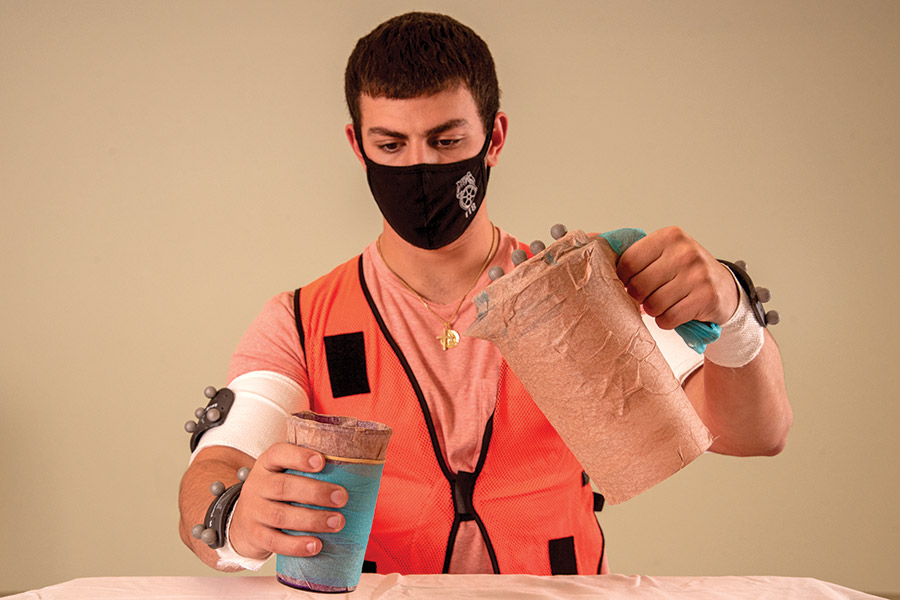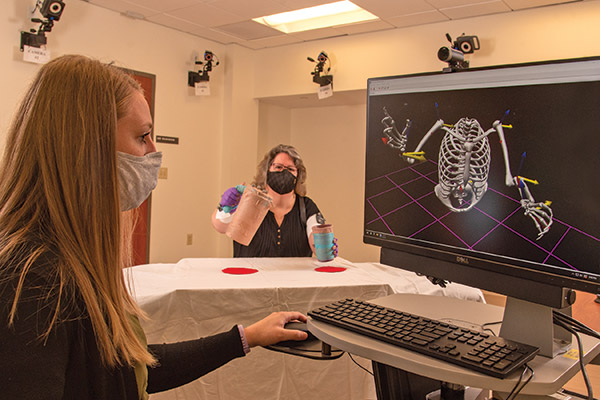LEARNING BY DOING
Pouring It Forward
Physical therapy students are among the first to use new high-tech equipment that has valuable implications for stroke patients.
by Emily Kirch

There is little research available about how stroke patients perform cross-body movements, such as pouring water from a pitcher into a cup — actions that engage both hemispheres of the brain.
It's a common task a lot of us take for granted: pouring a glass of water. But for those who’ve suffered a stroke, it might be a simple task they can no longer do. It’s also a task that requires the use of both arms. Surprisingly, there’s no research on how both arms work together to perform common functional tasks among this particular group. That’s why several physical therapy students are participating in a multi-phase research project to identify the challenges this population experiences and how interventions can better support recovery.
This research takes place partly because of the Motion Analysis Lab in Nazareth's York Wellness and Rehabilitation Institute. Look around the space and you’ll notice nearly a dozen cameras. They hang all around the room to capture three-dimensional data in real time. This state-of-the-art lab uses software that shows a skeleton animation that matches the individual’s motions. The individual wears sensors that measure joint range of motion and velocity.
“It was a little daunting at first to learn it all, but it's actually not that hard once you get the hang of it,” says Danielle Meeker ‘19, ‘21G. “It's very advanced. Few institutions have the technology to be able to do the stuff that we're doing right now, so it's very cool.”
Thirteen physical therapy students, composed of second- and third-year students, are part of the project, which Linda M. Riek, P.T., D.P.T., Ph.D., an associate professor in the Physical Therapy Department, is supervising.
Meeker and other third-year students are currently looking at how healthy adults move during a common task — like pouring the glass of water — to see how much they bend their elbow, reach their arm out, or twist their wrist. Later, the second-year students will look at the stroke population and compare the data.
“It's going to give us a basis to compare a non-stroke population to our stroke population, and it's going to give us a detailed analysis that just observing people isn't going to give us,” says Zachary Siracusa ‘22G. “It’s going to give us more detailed information on how every segment of the body is moving.” Siracusa is currently learning how to use the equipment and has even served as a subject, enabling third-year students to collect data on the healthy adult population.
“I find it pretty rewarding to be involved in their learning process,” says Meeker. “We all have a lot to learn throughout the program, and to be able to mentor them a little bit is an awesome experience.”
Because the available data is limited, students could have the opportunity to present their research at a national conference or publish in a peer-reviewed journal.
Once all the data has been collected, students will look at the differences between the two populations; then they’ll be able to target better interventions in the clinic. “We see the deficits that people who have had strokes have, and the daily struggles and all of their impairments,” Meeker says.
“Knowing that this research is likely going to help them just get a little bit better on a daily basis is really rewarding.”
Emily Kirch is a coordinator in the Marketing & Communications Department at Nazareth College.

There are nearly a dozen cameras in the Motion Analysis Lab, used along with sensors applied to an individual, to capture three-dimensional movement data.